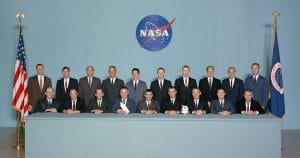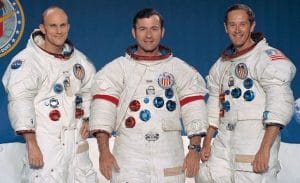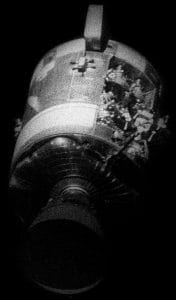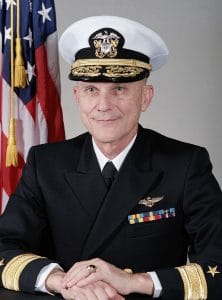With his father being an airline pilot, Mattingly said his “earliest memories … all had to do with airplanes,” so he not surprisingly was interested in flying himself. He set up a workshop in his family’s garage in Hialeah, Fla., when he was 9, and designed and built model airplanes there. He did better than you might expect: one of his models won the world speed record, and brought so many hobbyists to buy from him that local merchants complained about the unlicensed establishment, and the boy was forced to close up shop. He went on to earn his degree in aeronautical engineering from Auburn University, and joined the U.S. Navy to be a pilot, earning his wings in 1958. That was early enough that he started his Navy career in propeller aircraft, flying the Douglas A-1H Skyraider from the aircraft carrier USS Saratoga. After several years he moved to jets. He was unhappy when he couldn’t join the United States Naval Test Pilot School since it started while he was at sea, but was instead accepted at the U.S. Air Force Aerospace Research Pilot School at Edwards Air Force Base in California.

It turned out to be a good place at a good time: in September 1965, NASA started recruiting a new group of pilot-astronauts as it was gearing up to reach the moon, and Mattingly was one of 19 men (yes, at that point they were all white men) selected from about 5,000 applicants. He was assigned to work on the development of the Apollo spacesuit and backpack. His first flight assignment was to work CAPCOM for Apollo 8; only one controller at a time may speak on the radio to a crew in space — the CAPCOM, or Capsule Communicator. The mission went well. His next assignment was to be the backup Command Module pilot for Apollo 11, but wasn’t needed to fly, so he again served as one of the mission CAPCOMs. He was then assigned to go to the moon himself, also as Command Module pilot — not bad for his first-ever space mission.

NASA always has backups for each astronaut position in case of mishap or illness, and sure enough, 3 days before launch fellow astronaut Charles Duke caught rubella (German measles), and Mattingly was exposed and, in a crushing blow, pulled from the mission. He didn’t come down with the disease, so he instead served as CAPCOM for his would-be crewmates. That turned out to be an absolutely critical job, since the mission suffered a catastrophic explosion in an oxygen tank on the way to the moon, which severely damaged the Service Module: there was a very substantial chance that the Apollo 13 crew would run out of air long before they could get back to Earth. They were 200,000 miles away, and still headed toward the moon. Since Mattingly was the best-trained, yet still-on-the-ground, Command Module pilot, he played a pivotal role in helping to figure out how to save the crew.

The problem wasn’t a lack of oxygen, despite the loss of a key oxygen tank — they had enough, thanks to the unused tanks in the Lunar Excursion Module, or LEM. The problem was the LEM was equipped to sustain two men on the moon for two days, but it needed to sustain the full crew of three for the four days it would take to get them home. While there was just enough oxygen to do that, carbon dioxide would build up so much the crew would die anyway. First, flight controller John Aaron, along with Mattingly and several other engineers and designers, devised a procedure for powering up LEM; there was no prearranged procedure to do that during the cruise phase, but the undamaged LEM was needed to act as a lifeboat. Then the team had to figure out how to adapt the Command Module’s carbon dioxide filters to fit the LEM’s incompatible air system. Once that was all figured out, Mattingly took the lead in communicating instructions to the crew to implement the procedures, preserving their fresh air supply long enough to get home safely.
“It was very painful to be told a couple of days before launch that you are not going to go, but there was so much invested in this mission that it really was the only choice,” he said in an interview years later. “But I can guarantee you from a feelings point of view, I would have rather been there, no matter what happened.” Only after Apollo 13 crew landed and the debriefings completed did Mattingly marry his girlfriend, Elizabeth Bailey. But seeing how the press hounded astronaut families for any sort of “scoop” they could get, he refused to provide any details about her. Mattingly did finally get to go to the moon: he was assigned to Apollo 16, again as Command Module pilot while astronauts John Young and Charles Duke hopped — and drove around — on the moon’s surface. On the way back to Earth, it was Mattingly’s job to suit up and “space walk” to retrieve several film cassettes from the exterior of the Service Module.

After the successful Apollo 16 mission, Mattingly helped with the development of the Space Shuttle flight procedures, and flew on the fourth-ever Shuttle mission, the week-long 1982 STS-4 (on Columbia), and 1985’s STS-51-C (on Discovery), which at just 75-1/2 hours was the shortest space mission Mattingly flew. He shortly after retired from NASA and worked in the private sector working on Space Station support, and then was vice president in charge of the X-33 development at Lockheed Martin. Thomas Kenneth Mattingly II died in Arlington, Va., on October 31. He was 87.
Apollo 16 Trivia: In 2006, shortly after Hurricane Ernesto blew through Bath, North Carolina, Kevin Schanze, 11, found a 3-foot chunk of metal sheeting on the beach near his home with a “stamp” of the Apollo 16 mission insignia on it. NASA confirmed it was a piece of the first stage of the Saturn V rocket that had launched Apollo 16 into space. In July 2011, after returning the piece of debris at NASA’s request, Schanze was given an all-access tour of the Kennedy Space Center and VIP seating for the launch of STS-135, the final mission of the Space Shuttle program.
